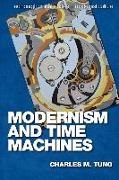Read more
Bridging modernist studies and science fiction scholarship
Modernism and Time Machines places the fascination with time in canonical works of twentieth-century literature and art side-by-side with the rise of time-travel narratives and alternate histories in popular culture. Both modernism and this cardinal trope of science fiction produce a range of effects and insights that go beyond the exhilarations of simply sliding back and forth in history. Taken together, the modernist time-obsession and the fantasy of moving in time help us to rethink the shapes of time, the consistency of timespace and the nature of history.
Charles Tung is Associate Professor of English at Seattle University.
List of contents
Acknowledgements
List of Figures
Introduction: Modernism, Time Machines, and the Defamiliarization of Time
1. The Heterochronic Past and Sidewise Historicity: Pablo Picasso, T. S. Eliot, and Murray Leinster
2. Alternate History and the Presence of Other Presents: Virginia Woolf, Philip Dick, and Christopher Nolan
3. Time Lags and Differential Pace: Bullet Time, William Faulkner, and Jessica Hagedorn
4. Temporal Scale, the Far Future, and Inhuman Times: Foresight in Wells and Woolf, Time Travel in Olaf Stapledon and Terence Malick
Conclusion
Bibliography
Index
About the author
Charles M. Tung is currently an Associate Professor of English at Seattle University. His publications have appeared in
ASAP/Journal,
Modernism/Modernity,
Configurations, and
Symploke.
Summary
Modernism and Time Machines' places the fascination with time in canonical works of twentieth-century literature and art side-by-side with the rise of time-travel narratives and alternate histories in popular culture.

